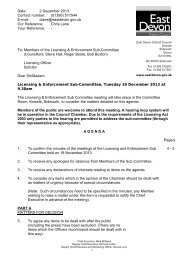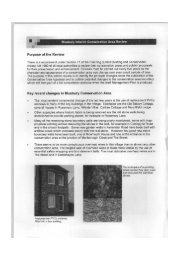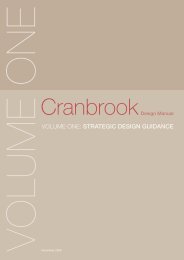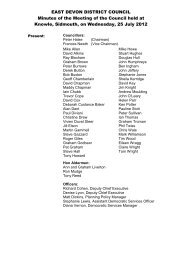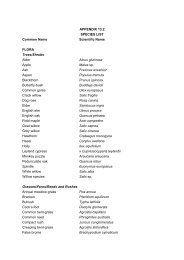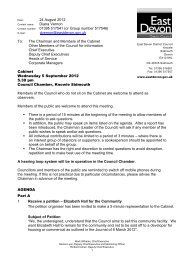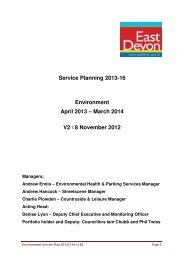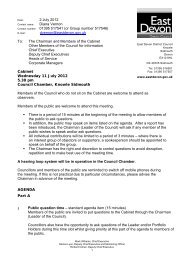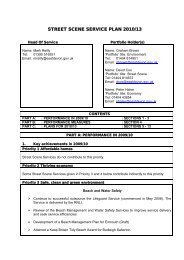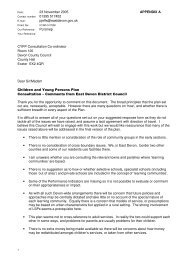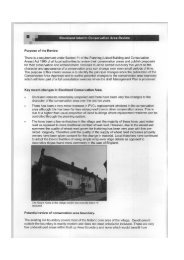Water Cycle Study - East Devon District Council
Water Cycle Study - East Devon District Council
Water Cycle Study - East Devon District Council
You also want an ePaper? Increase the reach of your titles
YUMPU automatically turns print PDFs into web optimized ePapers that Google loves.
2.2 Development scenarios<br />
Ref EWCS April 2010<br />
Exeter and <strong>East</strong> <strong>Devon</strong> <strong>Water</strong> <strong>Cycle</strong> <strong>Study</strong><br />
2.2.1 The development scenarios that have been used for this study are presented in Table 2.1 below.<br />
At the time of undertaking this WCS, the Regional Spatial Strategy for the South West was yet to<br />
be adopted. Hence in agreement with the respective Local Authorities, the development scenarios<br />
have generally used the growth figures of the Proposed Changes to the RSS, published by the<br />
Secretary of State in July 2008.<br />
Table 2.1 – Development scenarios<br />
Sub-region Location Secretary of State<br />
Proposed Changes<br />
Exeter City<br />
Teignbridge<br />
<strong>East</strong> <strong>Devon</strong><br />
Exeter City <strong>Council</strong> (including 500<br />
dwellings SW of Exeter in Area of<br />
Search 4C)<br />
South west of Exeter<br />
(Area of Search 4C)<br />
Development Target to 2026 (No. of Houses)<br />
Total tested by <strong>Water</strong><br />
<strong>Cycle</strong> <strong>Study</strong><br />
15,000 15,000<br />
2,000 2,000<br />
Cranbrook 7,500 10,000<br />
<strong>East</strong> of Exeter<br />
(Area of Search 4B)<br />
4,000 4,500<br />
Elsewhere in <strong>East</strong> <strong>Devon</strong> 5,600 5,600<br />
2.2.2 The areas of growth that are currently being considered to deliver these RSS development targets<br />
are shown in Table 2.2 and Figure 2.1overleaf, and are described below.<br />
Exeter City<br />
2.2.3 Development growth areas are identified to the east of Exeter City at Newcourt (approx. 3700<br />
dwellings, including 1200 dwellings with planning permission/subject to S106) and Monkerton/Hill<br />
Barton (approx 2300 dwellings) and to the south-west of Exeter at Alphington (approx. 600<br />
dwellings). In addition significant growth (8400 dwellings including 2000 windfalls) will also be<br />
required within Exeter’s existing urban area. These areas were identified as strategic areas for<br />
growth in the Preferred Options, but the revised housing numbers identified above will be<br />
consulted upon as part of the focused consultation in autumn 2009. This study will test the water<br />
cycle constraints, opportunities and capacities for these growth areas.<br />
<strong>East</strong> <strong>Devon</strong> <strong>District</strong><br />
2.2.4 The RSS (Proposed Changes) Policy HMA4 identifies an area of strategic growth of 7500 dwellings<br />
at new community Cranbrook and 4000 dwellings to the east of Exeter city (Area of Search 4B).<br />
2.2.5 An outline planning application for Cranbrook - currently at an advanced stage - is programmed to<br />
accommodate 2,900 dwellings (with supporting facilities and infrastructure), hence to meet the<br />
7,500 RSS target an additional 4,600 dwellings are required. The <strong>East</strong> <strong>Devon</strong> LDF Issues and<br />
Options Report [EDDC 2008b] identifies eight options for the expansion of Cranbrook.<br />
2.2.6 Although the Proposed Changes to the RSS identify a requirement for 4000 dwellings in Area of<br />
Search 4B in <strong>East</strong> <strong>Devon</strong>, there is no specific reference to this taking the form of a second new<br />
14




